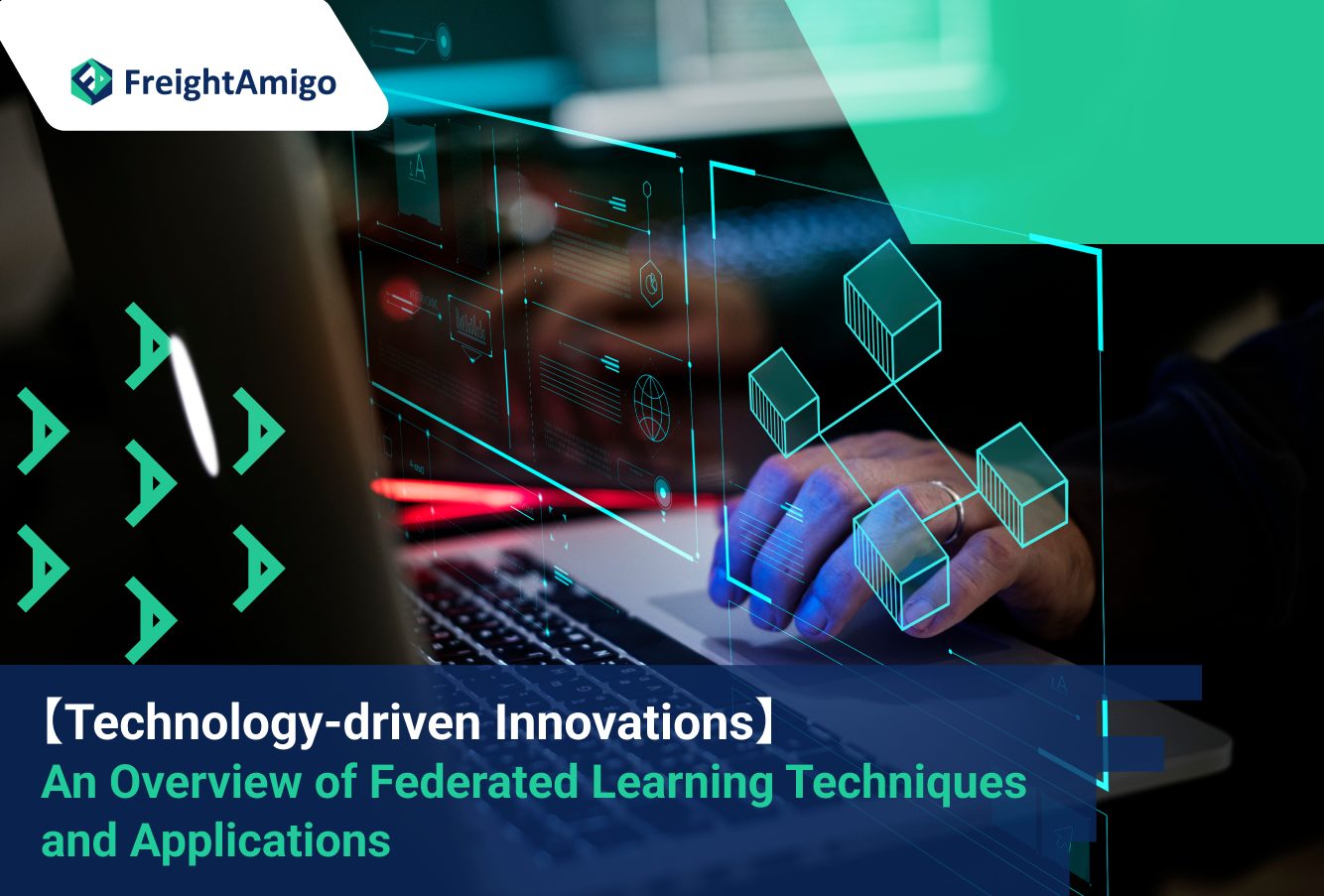February 1st, 2024: Maya Wong– Marketing Analyst at FreightAmigo
Federated learning has emerged as a revolutionary approach in the field of machine learning. It addresses the challenges of training machine learning models on decentralized data without compromising data privacy and security. This article provides an overview of the concept of federated learning, its importance, working principles, benefits, and core challenges. Additionally, it explores various applications of federated learning and its potential impact on industries such as supply chain management.
Want To Compare The Best Express, Air Freight, Sea Freight, Rail Freight & Trucking Rates So As To Have Better Control On Cost?
What is Federated Learning?
Federated learning is a machine learning technique that enables training of models on distributed data sources without the need for data centralization. Unlike traditional machine learning methods where data is collected and stored in a central server, it allows training models directly on individual devices or local servers. The model parameters are shared and aggregated, allowing collaborative learning without exposing the raw data.
The decentralized nature of federated learning ensures data privacy and security, making it an ideal solution for applications where sensitive or personal data is involved. In federated learning, the model is sent to the data, instead of the data being sent to a central location. This approach not only protects user privacy but also reduces the need for large-scale data transfer, enabling efficient utilization of network resources.
Why is Federated Learning Important?
Federated learning addresses several limitations of traditional machine learning approaches and offers unique advantages that make it a crucial technique in the era of data privacy and distributed computing. Here are some key reasons why it is important:
- Data Security: In traditional machine learning, centralizing data exposes it to potential security breaches. It keeps training data locally on devices or local servers, minimizing the risk of data exposure.
- Data Diversity: It enables the aggregation of data from multiple sources, leading to a more diverse and representative dataset. This diversity enhances the robustness and generalization capabilities of the trained models.
- Real-time Continual Learning: It facilitates continuous learning by allowing models to be updated with client data in real-time. This enables the adaptation of models to evolving data patterns and ensures the provision of up-to-date insights.
- Efficient Resource Utilization: By training models on edge devices or local servers, it reduces the need for extensive network communication and data transfer. This results in efficient utilization of network resources and improved scalability.
How Does Federated Learning Work?
The federated learning process involves several steps, starting from the distribution of the initial model to local devices or servers. Here is an overview of the federated learning workflow:
- Model Distribution: A pre-trained or uninitialized model is distributed to local devices or servers participating in the federated learning process.
- Local Model Training: Each device or server trains its local machine learning model using its respective dataset. The training process takes place locally without sharing the raw data.
- Results Aggregation: The trained local models send their updates or model parameters to a central server or aggregator. The aggregator combines these updates to create a global model.
- Global Model Refinement: The global model incorporates the aggregated updates and performs further optimization to improve its performance and accuracy.
- Knowledge Sharing: The refined global model parameters are shared with the participating devices or servers. This integration of global models into local models enhances the overall learning process.
By iteratively repeating these steps, federated learning enables collaborative training of machine learning models on decentralized data sources, resulting in improved models without compromising data privacy.
Benefits
Federated learning offers several benefits over traditional machine learning methods. Here are some key advantages of federated learning:
- Data Privacy: Federated learning allows training models without the need to transfer sensitive data to a central server, ensuring data privacy and compliance with privacy regulations.
- Efficient Resource Utilization: By leveraging local computing resources, federated learning reduces network communication and data transfer, resulting in efficient resource utilization.
- Improved Model Generalization: Federated learning enables the aggregation of diverse local datasets, leading to models that generalize better across different data distributions and sources.
- Real-time Learning: The iterative nature of federated learning allows models to continuously learn and adapt to evolving data patterns, ensuring up-to-date insights and predictions.
- Reduced Bias: Federated learning mitigates the risk of biased models by training on diverse datasets from various sources, reducing the impact of data imbalance or skewness.
These benefits make federated learning a promising approach for various applications where data privacy, efficient resource utilization, and model generalization are critical.
Core Challenges
While federated learning offers exciting opportunities, it also presents several challenges that need to be addressed for successful implementation. Here are some core challenges of federated learning:
- Communication Efficiency: Federated learning involves frequent communication between local devices or servers and the central aggregator. Ensuring efficient communication protocols and minimizing communication overhead are essential for scalability.
- Systems Heterogeneity: Different devices or servers may have varying hardware capabilities and computational resources. Developing techniques to handle the heterogeneity of systems is crucial for effective federated learning.
- Statistical Heterogeneity: Local datasets may have different statistical characteristics, leading to variations in local model performance. Proper handling of statistical heterogeneity is necessary to ensure accurate global model aggregation.
- Privacy Concerns: Although federated learning protects data privacy, there is still a need to address potential privacy risks, such as membership inference attacks or model inversion attacks. Incorporating privacy-preserving techniques is crucial for maintaining data confidentiality.
By addressing these challenges, federated learning can become a widely adopted technique for collaborative and privacy-preserving machine learning.
Applications of Federated Learning
Federated learning has diverse applications across various industries, including supply chain management, healthcare, finance, and more. Here are some prominent applications of federated learning:
- Supply Chain Management: In supply chain management, it can be used to train predictive models on data distributed across different nodes in the supply chain network. This enables accurate demand forecasting, inventory optimization, and supply chain risk management while maintaining data privacy and security.
- Healthcare: It is particularly beneficial in healthcare, where patient data privacy is of utmost importance. It allows models to be trained on data from multiple healthcare providers without sharing sensitive patient information. This enables collaborative disease prediction, personalized treatment recommendations, and medical image analysis.
- Finance: It can be applied to financial institutions for fraud detection, credit scoring, and risk assessment. By training models on distributed data sources, financial institutions can improve accuracy while complying with regulations regarding data privacy and security.
- Smart Cities: It can contribute to the development of smart cities by enabling the training of models on data collected from various sensors and devices. This facilitates real-time traffic management, energy optimization, and urban planning without compromising individual data privacy.
- Industrial IoT: In the industrial Internet of Things (IoT) domain, it allows collaborative training of machine learning models on edge devices or local servers. This enables predictive maintenance, anomaly detection, and optimization of industrial processes while preserving data privacy.
These applications highlight the potential of federated learning to revolutionize various industries by unlocking the value of distributed data while ensuring privacy and security.
Conclusion
Federated learning is a groundbreaking approach in machine learning that addresses the challenges of training models on decentralized data while preserving data privacy and security. By allowing models to be trained on local devices or servers, federated learning offers numerous benefits, including data privacy, efficient resource utilization, and improved model generalization. However, it also presents challenges such as communication efficiency, systems heterogeneity, statistical heterogeneity, and privacy concerns, which need to be addressed for successful implementation. With applications spanning across industries like supply chain management, healthcare, finance, and smart cities, federated learning has the potential to reshape the way machine learning models are trained and deployed.
There Are Different Options For Cargo Transportation. If You Want To Choose The Most Convenient And Suitable Solution, It Is Best To Have The Full Support Of Logistics Experts! If You Are Planning To Ship Goods Overseas, Please Go To The FreightAmigo Page For Inquiries.
===
Read More:
Securing the Future: Ensuring Data Privacy in Warehouse Robots Operations
【A Comprehensive Guide】 Big Data and Machine Learning in Financial Technology for Logistics
【Insurance & Risk Management】 The Transformative Power of Data-Driven Cargo Insurance
If you have any inquiries on logistics/supply chain, feel free to contact FreightAmigo now:
Chat with us online | Hotline: +852 28121686 | WhatsApp: +852 27467829



